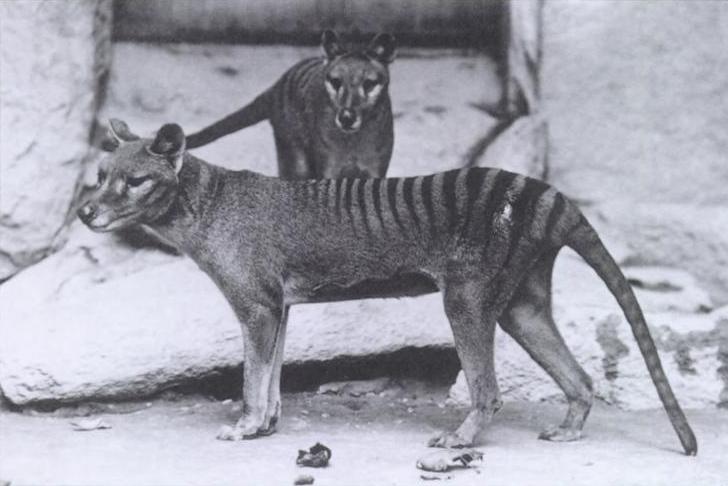Many years ago, several species of marsupial tiger called Australia home. Sadly, the last of our tigers, the Tasmanian Tiger, died out 90 years ago. But what was behind the fall of our other Australian tigers? Why was only the Tasmanian Tiger left?
According to a new study led by ANU and published in BMC Evolutionary Biology Journal, the answer might lie in the link between past climate change and the evolution of Australia’s carnivorous marsupials, such as the marsupial tiger family. In particular, the decline of the marsupial tiger family was found to be strongly linked with a 7°C drop in temperature that occurred around 13-14 million years ago.
This dramatic cooling event was not bad news for all, however. This same period of temperature change was found to be linked with a rise in the population of the beloved Tasmanian Devil and its relatives. To get to know more about this fascinating new research, I spoke to ANU PhD scholar Shimona Kealy about her experience working on this study.
Kealy, along with the University of Salford’s Dr Robin Beck, was responsible for conducting the most comprehensive dated tree-of-life study of the Australian carnivorous marsupial group to date. Their research involved developing 115 new post-cranial (below the head) bone characters. This was no small feat – as Kealy explains, ‘no one had ever really looked at the carnivorous marsupial skeleton and there had been absolutely no work done in a phylogenetic sense.’
To become so well acquainted with the bones of Australia’s carnivorous marsupials, Kealy recalls jumping right into the deep end: ‘On one of the first days of the project my supervisor (and co-author on the paper) Robin handed me a box full of loose bones. It was a quoll skeleton and I had to learn all the names of the bones and where they belonged – kind of like the ultimate jigsaw puzzle!’
This research aimed to reconcile the differing results of previous tree-of-life studies on carnivorous marsupials. These differences were a result of researchers separating their morphological studies (comparing physical features of the teeth and skull) and molecular studies (comparing DNA sequences). The solution used by Kealy and Beck was to combine the two. This combining of the datasets, as well as the development of their own data on some previously excluded species, produced spectacular results. Namely – they were able to produce the most complete total-evidence dataset for carnivorous marsupials yet!
Naturally, at this stage I had to ask – does all this mean there was more to the extinction of the Tasmanian Tiger than our hunting? Kealy suggested that, whilst hunting certainly played a significant role in eradicating the renowned Tassie Tiger, other vulnerabilities were at play. For instance, the Tasmanian Tiger was more vulnerable to extinction due to it being the last surviving species of its family. This vulnerability, combined with the population’s isolation on the small island of Tasmania, likely contributed to its rapid demise.
Aside from revealing the intriguing history surrounding the decline of our Australian tigers, the data and findings of this type of research are also useful for our current-day conservation efforts. As Kealy explains, ‘This sort of data can then be used by conservation strategists to develop the best models and methods for preserving Australia’s many threatened and endangered carnivorous marsupials.’
And whilst this study has already revealed some valuable findings for us to use, it is not the end of this line for this research. Leading on from this study, the team now have three hypotheses they’d like to test regarding the nature of the discovered links between climate change, tigers and devils. These are:
‘1) Climate caused the extinction of the tigers, which then provided empty niches for the devils and quolls to evolve into
2) The devil and quoll ancestors were better adapted to the cooler, drier climate (their ear structures provides some support for this) and so were able to out-compete the tigers and drive them to extinction
3) Or there is no link between the tigers and devils + quolls but they were both simultaneously affected by the changing climate.’
To test these theories, the research team hopes to have a closer look at the evolutions and extinctions of the individual species of carnivorous marsupials, and any environmental changes that occurred at these times. As such, this area of research is definitely one to keep an eye out for! And perhaps someday soon we will better understand the lives and struggles of our extinct Australian tigers.
We acknowledge the Ngunnawal and Ngambri people, who are the Traditional Custodians of the land on which Woroni, Woroni Radio and Woroni TV are created, edited, published, printed and distributed. We pay our respects to Elders past and present. We acknowledge that the name Woroni was taken from the Wadi Wadi Nation without permission, and we are striving to do better for future reconciliation.
